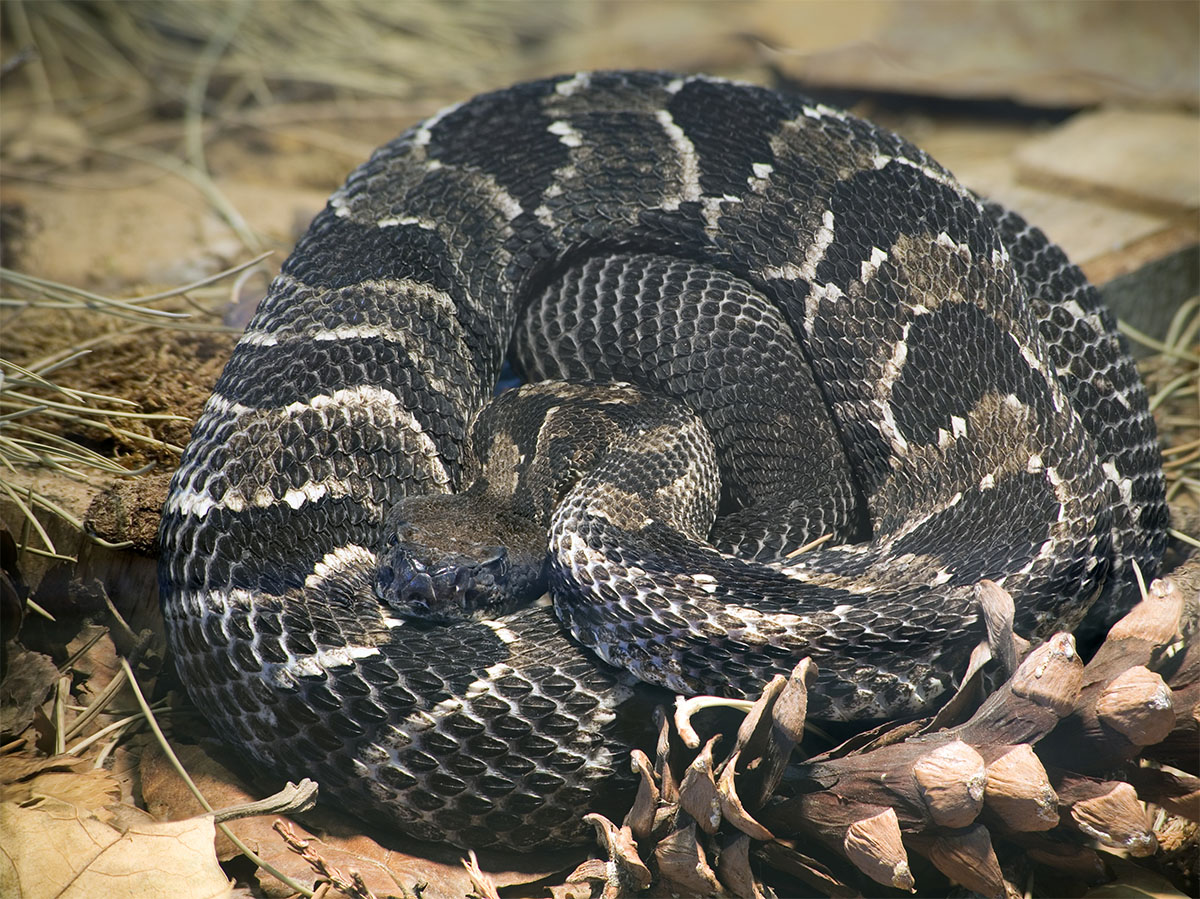Why It’s A Good Idea to Put Rattlesnakes in the Quabbin Reservoir

Timber Rattlesnake, Crotalus Horridus Horridus photo via Shutterstock
Snakes—they’re a tough sell.
Case in point: The uproar this week sparked by news that the Division of Fisheries & Wildlife plans to start placing a handful of endangered timber rattlesnakes on a remote island in the Quabbin Reservoir.
“Dear Massachusetts residents: Venomous rattlesnakes coming to an island near you,” The Washington Post quipped in its headline. MassLive made reference to “Rattlesnake Island” while Republican American noted, “picnicking strongly not advised.”
It’s easy to malign serpents, especially when they’re venomous. But concerns over MassWildlife’s conservation efforts are unfounded and shortsighted. Here’s everything you need to know about how this will work and why it’s important.
Where are the snakes going to be placed?
On Mount Zion, a roughly 1,400-acre island in the Quabbin Reservoir that’s off-limits to the public and mostly isolated from other parts of the reservoir.
It’s only a matter of time then before these rattlesnakes take over the island, right?
Definitely not. The Quabbin is loaded with animals that feast upon timber rattlesnakes, and there’s zero chance the snakes will ascend to apex predator status. For instance, black racer snakes, which are already on Mount Zion, eat juvenile timber rattlesnakes. Then there are red tail hawks, red shouldered hawks, great horned owls, barred owls, black bears, bald eagles, coyotes, red foxes, gray foxes, bobcats, and raccoons. “All of those eat rattlesnakes,” says Tom French of MassWildlife, who’s helping lead the project.
But won’t they breed like crazy, amassing a population that makes them an unstoppable venomous army?
Again, definitely not. Females usually don’t start reproducing until they’re 10 years old. From that point on, they only reproduce every three to five years, French says, adding that they pop out a measly nine eggs on average each time they breed. “In a lifespan of 30 years, she’ll have maybe six clutches of nine eggs. And when they’re young, their mortality is sky high; 80 percent or so in the early years,” French says.
Hold on. These things live for 30 years?
Well, they can. But up here, it’s really hard for them to do so. “We don’t get 30-year-old snakes anymore. They don’t survive long enough,” French says. That’s part of the reason they’re endangered in Massachusetts.
Well I’ve seen Snakes on a Plane and Anaconda, which have taught me that snakes always find a way and are a force to be reckoned with. Won’t these rattlesnakes eventually swim off the island and take over New England?
They’re decent swimmers, sure, but going into the open water would expose them to nearby bald eagles. Moreover, the first generation of snakes will have radio transmitters surgically implanted in them so scientist can track them. “If they leave, we’ll want to get them back,” French says. “We don’t want them dying. There’s no possibility that one will stray off.”
I don’t trust technology and I don’t have faith in natural predators. I’m pretty sure these snakes are going to get off the island and make my life hell.
Maybe this will mollify your concerns: Timber rattlesnakes are creatures of habit when it comes to hibernating, and they almost always return to the same spot each winter. “Our release effort will be focused on getting them attached to what we’re pretty certain is a historic hibernation site,” explains French. “Once they go underground and hibernate one winter, that is their hibernation site for life. In spring they will disperse from there, but they always have to turn around and come back.”
OK, it seems like they’re not going to escape. But this is Massachusetts, not Texas; rattlesnakes don’t belong here.
Sorry, but timber rattlesnakes have been here for centuries and were an important part of the ecosystem. But thanks to development, fear, and bloodlust, we eviscerated them. Today there are probably about 200 timber rattlesnakes across the state, and that number appears to be on the decline.
Yeah, but snakes are gross. Can’t we save something that’s cute or majestic?
That’s not how conservation works. We’ll let French take it from here: “The whole mission and purpose of the Division of Fisheries and Wildlife is to restore and manage this state’s biodiversity. Nobody really questioned that when we focused on restoring bald eagles. Ecologically, there’s no difference in the value of a bald eagle and a timber rattlesnake. The differences in value are personal—they’re what you think are important or not important. Ecologically there’s no difference and legally there’s no difference. It’s our mission and statutory mandate to protect the native wildlife of Massachusetts. It’d be irresponsible for us to sit back and watch this snake go down the tube and not try to do something about it.”
Touché. So how many of these snakes is MassWildlife going to dump on the island?
French says it’s not a matter of how many they’d like to release, it’s how many they’ll be able to get their hands on. In order to keep them from falling prey too soon, the first-generation of snakes will be reared in a lab for a few years before they’re placed on Mount Zion. “I’d bet it will be around one to 10 snakes a year, and I don’t think we can hope for anything beyond that,” he says.
That’s it?
Yep.


